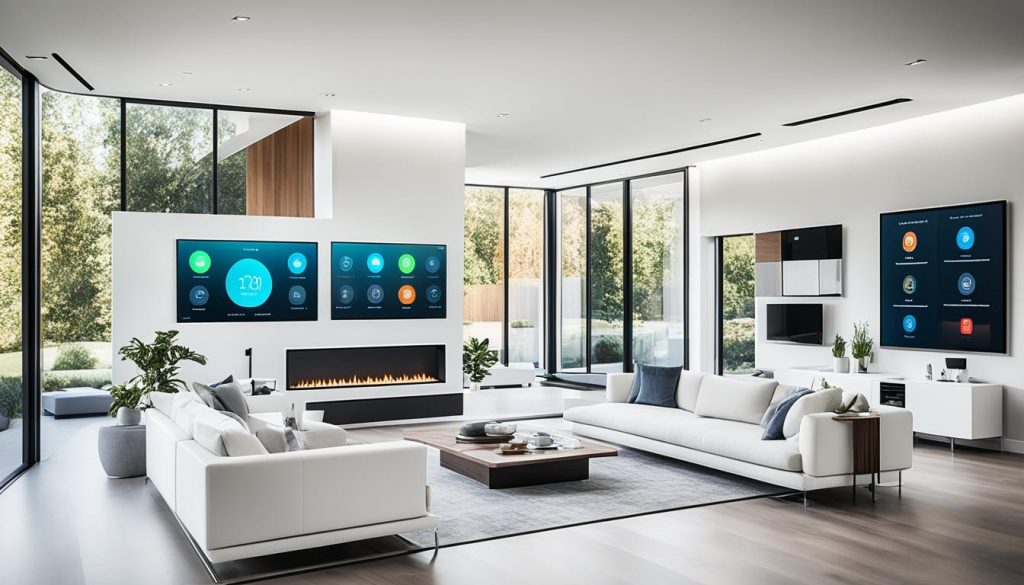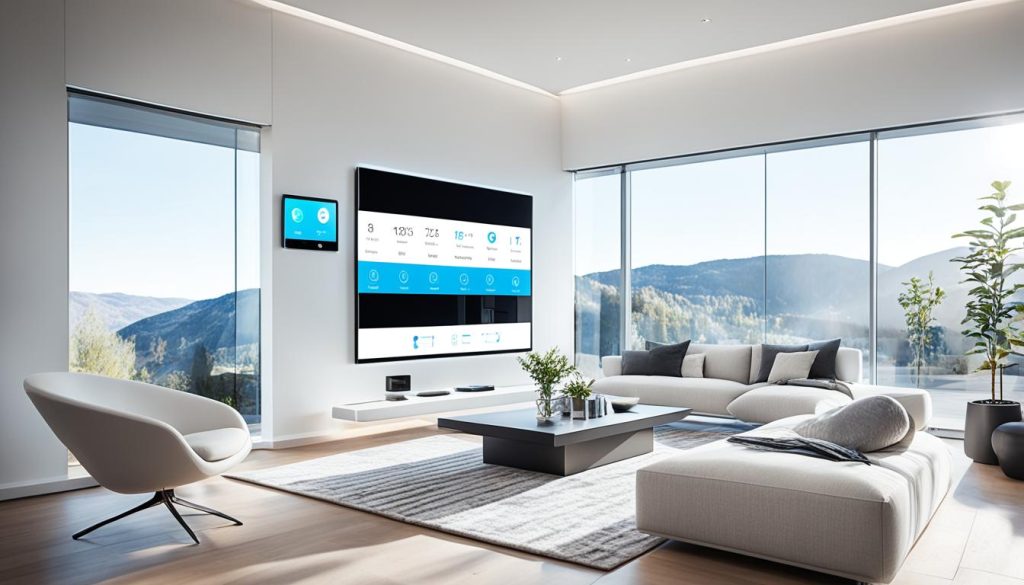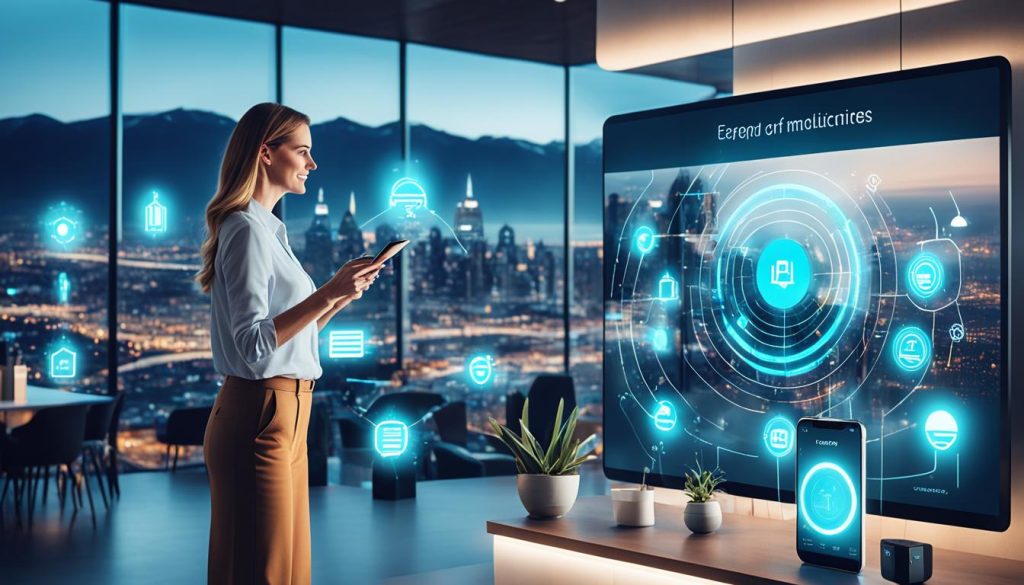Welcome to an era where automation has transcended its functional boundaries, ushering in a new wave of luxurious, connected experiences. The Internet of Things (IoT) has revolutionized the way we live, providing endless possibilities for seamlessly integrating smart devices into our daily lives. From smart homes to IoT solutions in various industries, IoT technology has transformed the way we interact with our surroundings.
In this article, we will explore the vast potential of IoT devices and their role in creating a more connected and luxurious lifestyle. We will delve into the growing landscape of IoT, its integration into industry verticals and consumer markets, and its functions in smart homes. Additionally, we will discuss the synergy between IoT and digital transformation, the key technologies powering smart home experiences, and the real-world benefits of IoT integration.
Finally, we will address the challenges that come with implementing IoT and highlight strategies for overcoming them. By the end of this article, you will have a comprehensive understanding of how IoT is shaping our lives and the opportunities it presents for businesses and individuals alike.
Key Takeaways:
- The Internet of Things (IoT) enables us to create luxurious and connected experiences beyond mere automation.
- IoT technology has transformed various industries and consumer markets, providing innovative solutions and enhancing efficiency.
- IoT functions in smart homes include seamless automation, remote access and monitoring, and energy efficiency.
- IoT device connectivity and control rely on networking technologies, smart sensors, and voice assistants.
- IoT integration offers real-world benefits, such as improved home automation, healthcare, energy management, transportation, and agriculture.
The Rise of IoT: Embracing a Digital Revolution in Lifestyle Enhancement
The Internet of Things (IoT) has emerged as a groundbreaking technology, paving the way for a digital revolution and transforming the way we live. With IoT, our daily lives are enhanced with connected devices that seamlessly integrate into our homes, creating a truly smart home infrastructure. This revolution is driven by the potential of IoT to enhance our lifestyle in ways we never imagined before.
The Growing IoT Landscape: Projected Growth to 29 Billion Devices by 2030
The IoT growth is staggering, with experts projecting the number of IoT devices to reach 29 billion by 2030. This exponential growth is indicative of the increasing adoption of IoT solutions and the potential it holds in various industries and sectors. As technology continues to advance, we can expect IoT to become an integral part of our daily lives, revolutionizing the way we interact with our environment.
The Impact of Smart Home Infrastructures: Transforming Day-to-Day Comfort
Smart home infrastructures, powered by IoT, have the potential to transform our day-to-day comfort. Through the seamless integration of IoT devices, our homes become intelligent, intuitive spaces that cater to our needs. From automated lighting and temperature control to smart security systems and connected entertainment, IoT enhances every aspect of our lifestyle, providing convenience, efficiency, and peace of mind.
IoT Integrating into Industry Verticals and Consumer Markets
In today’s rapidly evolving technological landscape, IoT integration has become a game-changer for both industry verticals and consumer markets. The seamless integration of IoT devices and solutions is reshaping the way businesses operate and individuals engage with everyday tasks.
The impact of IoT integration can be witnessed across various industry verticals. In sectors such as electricity, gas, steam & A/C, IoT technology enables efficient monitoring and management of energy systems, leading to optimized operations and cost savings. Water supply & waste management industries benefit from IoT’s ability to detect leaks, track water usage, and streamline waste disposal processes. Retail & wholesale industries utilize IoT for inventory management, supply chain optimization, and improving the overall customer experience. Smart cities leverage IoT to enhance urban infrastructure, transportation systems, and public safety measures. Additionally, the government sector adopts IoT to improve governance, enhance citizen services, and create sustainable smart cities.
In consumer markets, the adoption of IoT devices is transforming various sectors. Consumer internet & media devices are now interconnected, enabling personalized content delivery and seamless user experiences. Connected vehicles leverage IoT for real-time monitoring, predictive maintenance, and enhanced driving experiences. Healthcare industries are adopting IoT to enable remote patient monitoring, smart medical devices, and precision medicine. IT infrastructure benefits from IoT’s ability to optimize resource allocation, enhance security, and streamline data center operations. Agriculture is revolutionized by IoT-powered smart farming methods that enable precision farming, efficient resource management, and increased crop yields. The deployment of IoT in the smart grid allows for improved energy optimization, grid reliability, and integration of renewable energy sources.
With IoT integration spreading across industry verticals and consumer markets, the possibilities for innovation and growth are endless. As businesses and individuals continue to embrace IoT solutions, the potential for improved efficiency, enhanced experiences, and sustainable practices becomes even more apparent.

| Industry Verticals | IoT Integration Use Cases |
|---|---|
| Electricity, Gas, Steam & A/C | Efficient energy monitoring and management, cost savings |
| Water Supply & Waste Management | Leak detection, water usage tracking, streamlined waste disposal |
| Retail & Wholesale | Inventory management, supply chain optimization, improved customer experience |
| Smart Cities | Enhanced urban infrastructure, transportation systems, public safety measures |
| Transportation & Storage | Real-time monitoring, predictive maintenance, enhanced logistics |
| Government | Improved governance, citizen services, sustainable smart cities |
| Consumer Markets | IoT Integration Areas |
|---|---|
| Consumer Internet & Media Devices | Personalized content delivery, seamless user experiences |
| Connected Vehicles | Real-time monitoring, predictive maintenance, enhanced driving experiences |
| Healthcare | Remote patient monitoring, smart medical devices, precision medicine |
| IT Infrastructure | Resource optimization, enhanced security, streamlined data center operations |
| Agriculture | Precision farming, efficient resource management, increased crop yields |
| Smart Grid | Energy optimization, grid reliability, integration of renewable energy sources |
Unveiling the Functions of IoT in Smart Homes
The integration of Internet of Things (IoT) technology in smart homes brings forth a myriad of functions that enhance the way we interact with our living spaces. From seamless automation for superior home management to remote access and monitoring for modern home security, and energy efficiency through intelligent IoT solutions, the capabilities of IoT in smart homes are truly revolutionary.
Seamless Automation for Superior Home Management
One of the key functions of IoT in smart homes is providing seamless automation for superior home management. With IoT technology, homeowners can control and automate various tasks with ease. Adjusting thermostat settings, turning on/off lights, managing home entertainment systems, and controlling home security systems can all be done effortlessly through IoT-enabled devices and platforms. This level of automation not only enhances convenience but also contributes to a more comfortable and efficient living environment.
Remote Access and Monitoring: The Core of Modern Home Security
IoT’s role in smart home security cannot be underestimated. Remote access and monitoring are the core functions that help homeowners keep their homes safe and secure, even when they are away. Through IoT-enabled devices, homeowners can remotely monitor their home security systems, receive real-time alerts, and take necessary actions to mitigate potential risks. Whether it’s checking security camera feeds, locking doors, or controlling access to the property, IoT allows for enhanced control and peace of mind in modern home security.
Energy Efficiency through Intelligent IoT Solutions
One of the pressing concerns in modern living is energy efficiency. IoT offers intelligent solutions to address this challenge in smart homes. Through the integration of IoT devices, homeowners gain more control over their energy consumption. Smart thermostats, for example, can intelligently adjust temperature settings based on occupancy patterns, optimizing energy usage. Lighting systems can be automated to turn off when a room is unoccupied, reducing unnecessary energy waste. By leveraging intelligent IoT solutions, smart homes can significantly minimize energy wastage and promote a greener and more sustainable environment.
As the image depicts, smart home automation powered by IoT allows homeowners to control and automate various tasks, such as adjusting thermostat settings, turning on/off lights, managing home entertainment systems, and controlling home security systems.
Overall, the functions of IoT in smart homes provide homeowners with enhanced control, convenience, and security. From seamless automation to remote access and monitoring, and energy efficiency, IoT technology is transforming the way we manage and interact with our homes, ultimately leading to improved living experiences.
Smart Home Synergy: The Mechanics of IoT Device Connectivity and Control
The Significance of Data Collection in Automated Home Systems
The smart home experience is driven by the seamless connectivity and control of IoT devices. These devices form a network that allows homeowners to manage and automate various aspects of their homes, such as lighting, temperature, security, entertainment, and more. A key component of this interconnected ecosystem is data collection.
Data collection plays a significant role in automated home systems. IoT devices gather and analyze data from sensors, cameras, and other sources to optimize home functions and provide valuable insights for homeowners. For example, smart thermostats collect data on temperature patterns and occupancy to intelligently adjust settings and improve energy efficiency. Similarly, smart security systems use data collected from cameras and sensors to detect and respond to potential threats.
By leveraging data collection, automated home systems can learn and adapt to homeowners’ preferences and behaviors. With a better understanding of the residents’ daily routines and habits, IoT devices can anticipate needs, streamline operations, and enhance the overall smart home experience.
User Interfaces and Interaction: Personalizing the Smart Home Experience
In addition to data collection, user interfaces and interaction are crucial elements of the smart home experience. These interfaces facilitate communication between homeowners and their IoT devices, providing easy and intuitive ways to control and customize various aspects of the home.
User interfaces can take various forms, including smartphone apps, voice assistants, touch panels, and smart remotes. These interfaces enable homeowners to interact with their smart home devices using familiar methods and preferences. For instance, voice commands through smart speakers or virtual assistants allow for convenient and hands-free control, while mobile apps provide remote access and control from anywhere.
Personalization is key when it comes to user interfaces in smart homes. Homeowners can customize their settings, create schedules, and define automation rules based on their preferences, routines, and individual needs. This level of personalization empowers homeowners to tailor their smart home experience to match their lifestyle and optimize their comfort.

| Data Collection | User Interfaces |
|---|---|
| – Gather and analyze data to optimize home functions | – Smartphone apps for remote access and control |
| – Improve energy efficiency through intelligent insights | – Voice assistants for convenient hands-free control |
| – Enhance security through data from sensors and cameras | – Touch panels for intuitive interaction |
| – Learn and adapt to homeowners’ preferences and routines | – Smart remotes for easy control of multiple devices |
The Crossroads of IoT and Digital Transformation
In today’s rapidly evolving business landscape, the convergence of IoT technology and digital transformation has become a critical factor in driving innovation, enhancing efficiency, and unlocking new growth opportunities. The seamless integration of connected devices and AI-powered solutions has revolutionized traditional business operations, enabling organizations to stay competitive and meet the ever-changing needs of their customers.
Revolutionizing Business Operations with Connected Devices
Connected devices, powered by IoT technology, have reshaped the way businesses operate across various industries. From manufacturing and logistics to retail and healthcare, organizations are leveraging IoT to optimize processes, streamline operations, and deliver enhanced customer experiences. These devices enable real-time monitoring and data collection, allowing businesses to make data-driven decisions, improve efficiency, and reduce costs.
For example, in the manufacturing industry, IoT-enabled sensors embedded in equipment can provide valuable insights to optimize production, prevent downtime, and ensure efficient maintenance. In retail, IoT devices can track inventory levels, monitor customer behavior, and personalize shopping experiences to improve customer satisfaction. Moreover, in healthcare, IoT devices can enable remote patient monitoring, enhance patient care, and improve operational efficiencies.
The Role of AI in Enhancing Connectivity and Business Growth
AI plays a crucial role in the IoT ecosystem by enabling seamless connectivity, advanced analytics, and automation. With AI-powered algorithms, businesses can leverage the vast amounts of data generated by IoT devices to gain valuable insights, make informed decisions, and drive business growth.
AI-powered analytics can help businesses uncover patterns, identify trends, and optimize processes. For example, in predictive maintenance, AI algorithms can analyze data from IoT sensors to anticipate equipment failures and schedule proactive maintenance, reducing downtime and improving operational efficiency. In customer service, AI-powered chatbots can provide instant and personalized assistance, enhancing customer satisfaction and reducing response times.
Furthermore, AI-driven automation can streamline business operations, improve productivity, and enable organizations to scale their operations. From robotic process automation to autonomous vehicles, AI combined with IoT devices can transform the way businesses operate, reducing human error, increasing efficiency, and facilitating business growth.
As digital transformation continues to reshape industries, the strategic integration of IoT devices and AI becomes crucial for businesses aiming to stay competitive in the digital era. By leveraging the power of connected devices and harnessing the insights provided by AI, organizations can revolutionize their business operations, enhance connectivity, and drive sustainable growth.
Key IoT Technologies Powering Smart Home Experiences
In order to create seamless and connected smart home experiences, several key IoT technologies come into play. These technologies enable device connectivity, control, and automation, revolutionizing the way we interact with our living spaces. In this section, we will explore the networking technologies that enable smart home functionality, as well as the role of smart sensors and voice assistants in automating homes.
Networking Technologies: Wi-Fi, Zigbee, and Z-Wave
Networking technologies form the backbone of smart home connectivity, allowing devices to communicate with each other and with the broader internet. Wi-Fi, Zigbee, and Z-Wave are three prominent networking technologies in the IoT ecosystem.
Wi-Fi, a ubiquitous wireless networking technology, enables devices to connect to the internet and communicate with each other within a local network. It provides a high-speed and reliable connection for smart home devices, allowing users to control and monitor various aspects of their homes remotely.
Zigbee is a low-power wireless communication protocol designed for short-range, low-data-rate devices within a smart home network. Zigbee’s mesh network topology allows devices to act as routers, extending the network’s range and enabling devices to communicate with each other even if they are not directly connected to a central hub.
Z-Wave is another wireless communication protocol specifically developed for smart home devices. It operates on a different frequency than Wi-Fi and Zigbee, reducing interference and enhancing reliability. Z-Wave devices form a mesh network, enabling seamless connectivity and control throughout the home.
Together, Wi-Fi, Zigbee, and Z-Wave provide the necessary connectivity infrastructure to support a wide range of IoT devices and services, creating a unified and integrated smart home ecosystem.
The Role of Smart Sensors and Voice Assistants in Automating Homes
Smart sensors play a crucial role in automating various aspects of a smart home. These sensors collect data about the environment, such as temperature, humidity, light, motion, and more. This data is then used to trigger automated actions or provide valuable insights to homeowners. For example, a smart thermostat uses temperature and occupancy sensors to adjust heating and cooling settings based on occupancy patterns and user preferences, optimizing energy consumption and comfort.
Voice assistants, such as Amazon Alexa and Google Assistant, have become an integral part of many smart homes. These virtual assistants enable users to control their smart home devices using voice commands, providing a convenient and intuitive interface for automation and control. By simply speaking commands, users can turn on lights, adjust the thermostat, play music, and even control other connected devices like TVs and appliances.
By harnessing the power of smart sensors and voice assistants, homes can become more automated, responsive, and personalized, enhancing the overall smart home experience for users.

Internet of Things (IoT) and Smart Devices
In the era of digital transformation, the Internet of Things (IoT) and smart devices have emerged as the backbone of personalized and connected living. IoT technology revolutionizes the way we interact with our surroundings, enabling seamless connectivity and personalized experiences. With the proliferation of smart devices, our homes, cities, and workplaces are transforming into intelligent ecosystems that enhance our quality of life.
The Backbone of Personalized and Connected Living
IoT technology forms the foundation of personalized and connected living, enabling us to create tailored environments that cater to our individual preferences. Through connected devices and platforms, we can customize our living spaces, control various aspects of our homes, and manage our daily routines effortlessly. Whether it’s adjusting the lighting, temperature, or entertainment systems, IoT empowers us to curate an environment that aligns with our unique needs and lifestyle.
Data-Driven Innovations: The Edge for Modern Consumer Engagement
One of the key advantages of IoT and smart devices is their ability to leverage data-driven innovations, enhancing consumer engagement and improving the overall customer experience. Through data collection and analysis, businesses can gain valuable insights into consumer behavior, preferences, and trends. This enables them to deliver personalized and targeted experiences, tailor their products and services, and build lasting relationships with their customers.
IoT enables businesses to connect with consumers on a deeper level, offering products and services that cater to their exact needs and desires. By leveraging the power of data-driven innovations, companies can create customized experiences that resonate with consumers, fostering loyalty and brand advocacy.
In conclusion, the Internet of Things (IoT) and smart devices have revolutionized the way we live and interact with the world around us. They form the backbone of personalized and connected living, empowering us to create customized environments and experiences. Moreover, data-driven innovations driven by IoT technology provide businesses with the edge to engage consumers in a more meaningful and personalized way. As IoT continues to evolve, we can expect further advancements that will further enhance our everyday lives.
Illuminating Real-World Benefits of IoT Integration
In this section, we will explore the real-world benefits of IoT integration and how it positively impacts various aspects of our lives. From home automation to healthcare, energy management to transportation, and even agriculture, IoT integration offers numerous advantages that improve efficiency, enhance safety, and promote sustainability in different industries.
IoT integration in home automation brings convenience and luxury to residents. With IoT devices such as smart thermostats, lighting systems, and security cameras, homeowners can control and manage their homes remotely, creating a comfortable and secure environment. IoT-enabled home automation systems optimize energy consumption, reducing utility bills and promoting eco-friendly practices.
In the field of healthcare, IoT integration enables remote patient monitoring, improving access to care and enhancing patient outcomes. IoT devices like wearables and medical sensors can continuously monitor vital signs and transmit data to healthcare providers in real-time. This integration helps doctors remotely monitor patients’ health, allowing for early intervention and personalized treatment plans.
When it comes to energy management, IoT integration plays a crucial role in optimizing energy usage and reducing waste. IoT-enabled smart grids and energy monitoring systems provide real-time data on energy consumption, allowing users to make informed decisions and adjust energy usage accordingly. This integration promotes energy efficiency, minimizes environmental impact, and supports sustainable practices.
In the realm of transportation, IoT integration is revolutionizing mobility and enhancing safety. Connected vehicles equipped with IoT devices can gather data on road conditions, traffic patterns, and driver behavior, enabling real-time navigation and efficient route planning. IoT integration also facilitates vehicle-to-vehicle and vehicle-to-infrastructure communication, promoting safer driving and reducing accidents.
Furthermore, IoT integration in agriculture is transforming farming practices, promoting precision agriculture, and improving crop yields. IoT devices such as soil sensors, weather monitors, and automated irrigation systems gather data on environmental conditions, allowing farmers to monitor and optimize crop growth. This integration helps farmers make data-driven decisions, reduce resource wastage, and increase productivity.

Through concrete examples and case studies, we will delve deeper into these real-world benefits of IoT integration, showcasing the positive impact it has on different industries and sectors. By harnessing the power of IoT integration, businesses and individuals can unlock new opportunities for growth, efficiency, and sustainability.
Overcoming Challenges in IoT Implementation
Navigating Data Security in the IoT Epoch
Implementing IoT technology comes with its fair share of challenges, one of the most critical being data security. In the IoT epoch, where devices are interconnected and exchange vast amounts of sensitive information, safeguarding data has become a top priority. Organizations need to implement robust cybersecurity measures that encompass encryption, authentication, and access control to protect the integrity and confidentiality of data. Additionally, continuous monitoring and threat detection systems are essential to identify and respond to any potential breaches effectively. By prioritizing data security, businesses can instill trust in their IoT implementations and ensure the privacy and protection of both their customers and their proprietary information.
Addressing Compatibility and Integration Issues for a Unified IoT Ecosystem
Another significant challenge in IoT implementation is addressing compatibility and integration issues to create a unified IoT ecosystem. With a vast array of IoT devices, platforms, and protocols available, ensuring seamless connectivity and interoperability can be complex. Organizations must focus on standardization and adhere to established communication protocols to facilitate the smooth integration of devices and platforms. Compatibility testing and interoperability certifications play a crucial role in identifying and resolving any issues that may arise during implementation. By addressing these challenges head-on, businesses can create a unified IoT ecosystem that maximizes the potential of connected devices and enables them to work together seamlessly, ultimately creating smarter and more efficient solutions.
In conclusion, overcoming challenges in IoT implementation is essential for organizations to unlock the full potential of IoT technology. This involves navigating data security concerns and addressing compatibility and integration issues to ensure a unified IoT ecosystem. By doing so, businesses can harness the power of IoT to drive innovation, improve operational efficiency, and deliver transformative connected experiences.
Conclusion
Throughout this article, we have explored the transformative potential of IoT and its impact on various industries and lifestyles. From smart homes to business operations, IoT has the power to revolutionize the way we live and work.
By integrating connected devices and leveraging data-driven innovations, IoT enables personalized and connected living. It enhances comfort and convenience in our everyday lives, while also improving efficiency and sustainability in industries such as healthcare, energy management, transportation, and agriculture.
Embracing IoT technology is crucial for businesses and individuals to stay competitive in the digital age. The projected growth of the IoT landscape suggests that it is here to stay, with 29 billion devices expected by 2030. By embracing IoT, companies can enhance their operations, optimize processes, and improve customer experiences.
In conclusion, IoT is more than just automation. It is a catalyst for creating luxurious, connected experiences. By harnessing the power of IoT, we can transform the way we live, work, and interact with our surroundings. The opportunities presented by IoT are immense, and it is up to us to seize them and embrace this digital revolution fully.
FAQ
What is IoT?
How does IoT revolutionize our lifestyles?
What industries are integrating IoT technology?
How can IoT enhance the functions of a smart home?
How do IoT devices connect and control in smart homes?
How does IoT impact businesses and digital transformation?
What are the key technologies powering smart home experiences?
How does IoT support personalized and connected living?
What are the real-world benefits of IoT integration?
What challenges are associated with IoT implementation?
Source Links
- https://www.linkedin.com/pulse/know-future-living-iot-smart-maven-technology-ltd-04jvf
- https://www.one-beyond.com/the-synergy-of-iot-and-digital-transformation/
- https://essentialnetworktech.com/the-iot-revolution-and-your-business/
